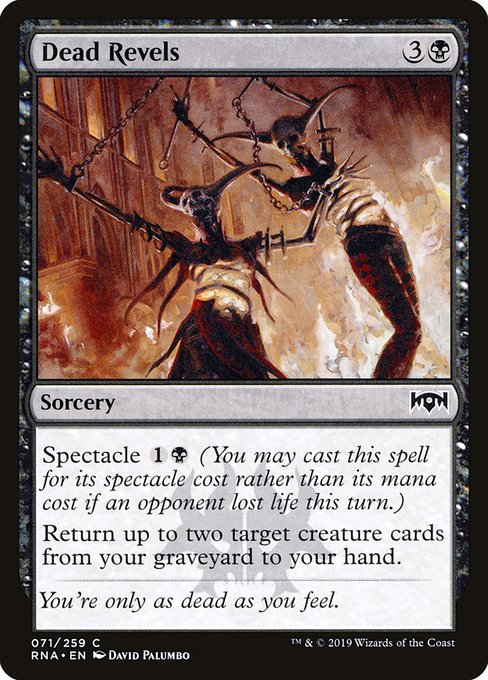
Image courtesy of Scryfall.com
Rarity, Recursion, and Rakdos Rhythm
Magic design often walks a fine line between power and playability, especially when you thread a card through the three acts of rarity, set balance, and player experience. Dead Revels, a common from Ravnica Allegiance, is a neat lens for watching that balance in action. At first glance, you might dismiss a 3B sorcery as colorless enough to merit a common slot, but the real magic lies in its Spectacle option and graveyard recursion. The card’s core text—“Return up to two target creature cards from your graveyard to your hand”—turns a stumble in board position into a second wind, especially when the spectacle cost nudges the mana curve in a different direction. And for Rakdos fans, the temptation to accelerate hurt with a cheaper cost whenever an opponent loses life adds a delicious edge to tempo-rich games. 🧙♂️🔥
From a rarity perspective, Dead Revels demonstrates how a lower-rarity card can still exert meaningful influence on both formats. Common cards must avoid eclipsing more ambitious rares and mythics, yet they should still offer tangible, repeatable value. This is where the rarity scaling philosophy comes into play: a common like Dead Revels must feel good in limited, while remaining a credible piece in constructed decks that lean into graveyard themes. Its Spectacle cost aligns with RNA’s design ethos—an optional, context-dependent alternative cost that rewards aggressive play and life-loss skirmishes without steering players toward degenerate, stompy strategies. The result is a set where a single common can thread through multiple archetypes without destabilizing the overall power curve. ⚔️
How Dead Revels shapes deckbuilding and metagame tempo
In Limited, Dead Revels shines when you’re already painting a crowd of creatures in the graveyard or when you’re counterpunching removal-heavy boards. The ability to fetch up to two creatures back into hand is a tempo swing, offering card advantage while you refill threats for the next dance. The spectacle cost—two mana and black mana symbols if an opponent lost life that turn—encourages you to lean into life-loss triggers, creating a race to pressure the board and the opponent’s life total. In practice, you’re not just reanimating; you’re reloading with a plan to pressure quickly, which situationally elevates the card above its nominal common rating. 🧠🎲
In Constructed formats that allow graveyard interaction, Dead Revels remains a niche but credible option for decks that lean on resource parity and resilience. It doesn’t demand a full-blown graveyard strategy to shine, yet it rewards players who curate a yard-friendly engine. That pairing—two flesh-and-blood bodies returning to hand while you manage mana and life-loss triggers—exemplifies how set balance can keep a card relevant across multiple formats without tipping the scales toward overpowered archetypes. The flavor text—“You’re only as dead as you feel.”—pairs nicely with a gameplay line: even when you’re behind, your options aren’t gone; they’re simply waiting in the graveyard to rise again.
You're only as dead as you feel.🧙♂️💎
Set balance in a bustling blockbuster block
Ravnica Allegiance is a block built around ten guilds, each with its own mechanical flavor. Spectacle is one of the standout tools that helps control both draft density and late-game decisions. Cards like Dead Revels show that a common slot can carry meaningful upside without saturating the format with over-the-top effects. The set-wide scarcity model relies on a mix of recursions, bargain costs, and interactive elements that feel flavorful and accessible. When a card like Dead Revels exists at common, it nudges players toward creature-focused strategies while ensuring that the payoff remains balanced by cost, timing, and the availability of graveyard resources. The overall result is a healthier metagame where players value tempo, trades, and strategic planning over mere raw power. 🔥🎨
Value, art, and market heartbeat
From a collector perspective, Dead Revels sits in a comfortable space: it’s a foil-friendly common with a historically modest price tag. Current market data places non-foil around a few cents, while foils fetch a bit more. That gap reflects its role as a reliable, affordable pickup for budget decks and casual collectors who want to curate a robust Rakdos toolbox without breaking the bank. The card’s black mana identity and its flavorful flavor text add a little extra spark for lore-minded players, who enjoy the idea that even a “dead” card can pivot back into the action with just the right spectacle. The value story here is less about radical price appreciation and more about steady utility and nostalgic appeal for RNA-era fans. 💎
Curious players and deck-builders can explore more across our network as they plan their next caffeine-fueled drafting session or late-night grind on Arena. And if you’re looking to pair your MTG hobby with everyday gear, check out practical accessories that keep you playing smoothly—like the sleek, clear silicone phone case that doubles as a reliable companion for your on-the-go gaming life. 🧙♂️🎲
Clear Silicone Phone Case – Slim Profile
More from our network
- https://transparent-paper.shop/blog/post/blue-white-giant-reveals-evolution-through-temperature-gradients/
- https://blog.digital-vault.xyz/blog/post/designing-irresistible-clipart-packs-for-crafters/
- https://crypto-acolytes.xyz/blog/post/solana-meme-coin-3-on-chain-risks-amid-rising-momentum/
- https://blog.rusty-articles.xyz/blog/post/liverpools-four-game-losing-streak-should-the-champions-worry/
- https://blog.crypto-articles.xyz/blog/post/psa-vs-bgs-grading-for-diggersby-which-holds-value/